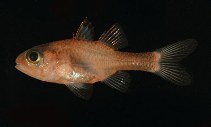| Family: |
Apogonidae (Cardinalfishes), subfamily: Apogoninae |
| Max. size: |
5 cm TL (male/unsexed) |
| Environment: |
reef-associated; marine; depth range 18 - 55 m |
| Distribution: |
Indo-Pacific. Replaced by Apogon coccineus from the Red Sea to Persian Gulf and by Apogon erythrinus in the Hawaiian Islands (Ref. 37816). |
| Diagnosis: |
Dorsal spines (total): 7-7; Dorsal soft rays (total): 9-9; Anal spines: 2-2; Anal soft rays: 8-8. Distinguished by having the following characteristics: dorsal-fin rays VI-I, 9; anal-fin rays II,8; pectoral fin rays 13; pelvic fin rays I,5; pored lateral line scales 24; predorsal scales 5-6; large scale between first dorsal fin and lateral line 1; circumpeduncular scales 12; total gill rakers 15-16, developed gill rakers 8-9; full scale between first dorsal fin and lateral line 1, often with smaller second scale (Ref. 93839). Resembles A. unicolor but distinguished by fewer spines in the 1st dorsal fin (6 against 7), large scales, and fewer lateral line scales (23 against 25). Body color uniformly dark reddish, each scale mottled with brown. Attains 10 cm TL. Further characterized by having a semi-transparent red color, with a thin, dark red stripe on mid-lateral surface of the body (Ref. 93839) greatest depth of body 2.7-3.0 in SL (Ref. 90102). |
| Biology: |
Found on inshore reefs, lagoons, and seaward reefs (Ref. 37816). Nocturnal species (Ref. 7300). Feeds on small benthic crustaceans (Ref. 37816). Maximum depth reported taken from Ref. 57178. |
| IUCN Red List Status: |
Least Concern (LC); Date assessed: 05 February 2021 Ref. (130435)
|
| Threat to humans: |
harmless |
Source and more info: www.fishbase.org. For personal, classroom, and other internal use only. Not for publication.

